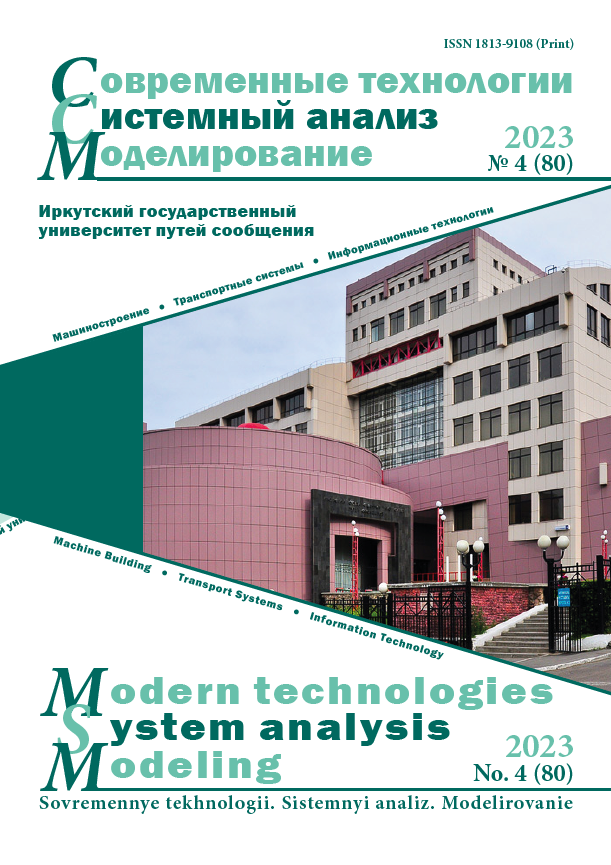Modeling of thermal fields distribution on the friction surfaces of composite brake linings of railway rolling stock disk brakes
Keywords:
rolling stock, disc brakes, brake disc, brake linings, coefficient of friction, heat flux density, finite element analysis, thermal fieldAbstract
The article discusses the important role of express and high-speed rolling stock in the railway transport of the Russian Federation. High performance braking systems are required to ensure the needed level of traffic safety. Disc brakes belong to such braking devices. One of the solutions providing the necessary technical characteristics of disc brakes is to conduct computer simulation of the operation of the selected type of braking equipment, in particular, modeling thermal processes during braking. It is indicated that disc brakes are among the most suitable for express and high-speed rolling stock, as they have significant technical advantages. The main drawback of standard brake pads for locomotives and wagons has been identified. The necessity is noted to take into account the heating temperature of the friction elements in the design of the brakes of rolling stock, since the value of the friction coefficient depends on this factor, and thus the braking efficiency. The design and purpose of the main elements and components of disc brakes are considered on the example of the electric train ES1 «Swallow». Composite brake linings with varying degrees of wear have been modeled in the KOMPAS-3D CAD for further research. The calculation of the change in the friction coefficient and braking force during braking of rolling stock equipped with disc brakes is carried out. According to the theory of proportionality of the mechanical and thermal power released during friction of the brake linings on the disc, the heat flux density is determined. The heat flux coefficients for both the brake disc and the brake linings are determined. The process of finite element analysis in the MSC Patran/Marc environment is described. The simulation results are presented with an illustration of the distribution of thermal fields on the friction surfaces of brake linings with different degrees and forms of wear. Conclusions are drawn about the effect of wear on the maximum heating temperature of the brake linings.
References
Родченко В.А., Зандарашвили Д.С. Высокоскоростное железнодорожное движение. Мировой опыт и перспективы в России. М. : МГУПС (МИИТ), 2015. 116 с.
Ксенофонтова Т.Ю., Коклева Н.Е., Далингер Я.М. Роль инновационных технологий скоростного движения железнодорожного транспорта в инфраструктурном развитии регионов // Экономика устойчивого развития. 2022. № 2 (50). С. 110–114.
Куренков П.В., Поляева Т.И. Развитие скоростного железнодорожного движения в КНР // Вестник транспорта. 2011. № 9. С. 37–43.
Быкадоров С.А. Проблемы повышения скорости движения на железнодорожном транспорте // Регион: Экономика и Социология. 2005. № 1. С. 150–163.
Быкадоров С.А. Современные проблемы высокоскоростного движения на железнодорожном транспорте // Логистика – евразийский мост : материалы XIII Междунар. науч.-практ. конф. Красноярск, 2018. Ч. 1. С. 36–48.
Мошков А.А., Сипягин Е.С. Разработка дискового тормоза для отечественного скоростного железнодорожного транспорта // Транспорт Российской Федерации. 2013. № 6 (49). С. 62–65.
Применение методов термического анализа при исследовании влияния температуры на фрикционную основу тормозных колодок автомобиля / Л.В. Дашко, A.В. Довбня, B.Ю. Ключников и др. // Пожаровзрывобезопасность. 2013. Т. 22. № 6. С. 68–73.
Анисимов П.С. Тормозное оборудование высокоскоростных поездов // Железнодорожный транспорт. 2011. № 2. С. 72–77.
Петров А.О. Влияние тепловых процессов в колесе вагона на безопасность движения поездов // Вызовы глобализации и развитие цифрового общества в условиях новой реальности : сб. материалов IX Междунар. науч.-практ. конф. Пятигорск, 2023. С. 33–37.
Сравнительный анализ колодочных и дисковых тормозных систем железнодорожного подвижного состава / Д.Ю. Белан, М.С. Давыдов, Н.С. Прокопенко и др. // Молодежь и системная модернизация страны : сб. науч. ст. междунар. науч. конф. студентов и молодых ученых. Курск, 2016. Т. 2. С. 175–178.
Полозков А.В. Применение дискового тормоза на электроподвижном составе // Организация производства, экономика и менеджмент : тр. III студен. науч.-практ конф. Воронеж, 2022. С. 89–91.
Об утверждении правил тяговых расчетов для поездной работы : распоряжение ОАО «РЖД» от 12.05.16 № 867р (ред. 02.02.2018). Доступ из справ.-правовой системы АСПИЖТ в локал. сети.
Исследование температуры тормозных колодок с разной степенью износа в процессе фрикционного торможения / П.Ю. Иванов, А. М. Худоногов, Е. Ю. Дульский и др. // Вестн. Урал. гос. ун-та путей сообщ. 2020. № 3 (47). С. 27–34.
Study of the influence of the brake shoe temperature and wheel tread on braking effectiveness / P.Yu. Ivanov, A.M. Khudonogov, E.Yu. Dulskiy et al. // International scientific conference energy management of municipal facilities and sustainable energy technologies. Voronezh, 2019. Vol. 1614. DOI 10.1088/1742-6596/1614/1/012086.
Тищенко П.А. Нестационарные температурные поля в элементах дискового тормоза скоростного вагона с учетом нестабильности теплового контакта : дис. … канд. техн. наук. Брянск, 2003. 175 с.
Мишин А.А. Математическое моделирование нестационарных температурных полей и напряжений в деталях дискового тормоза вагона : дис. … канд. техн. наук. Брянск, 2011. 161 с.
Мишин А.А. Расчет температурных полей и напряжений в деталях дискового тормоза скоростного вагона // Вестн. науч.-исслед. ин-та ж.-д. трансп. 2010. № 6. С. 38–42.
Моисеенко М.А., Сакало В.И. Моделирование температурных полей в деталях дискового тормоза // Вестн. Брян. гос. техн. ун-та. 2009. № 2 (22). С. 57–64.


